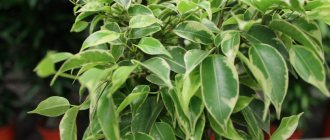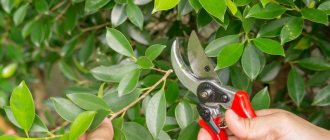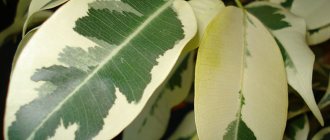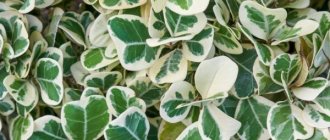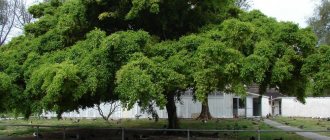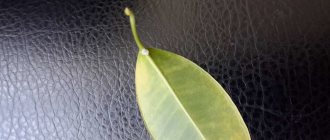Ficus is a fairly popular indoor plant. Most often you can find Ficus Benjamin in homes and offices. It does not require special growing conditions, which is why it is so loved. But in order to maintain its decorative qualities, you need to provide it with adequate nutrition. Properly selected fertilizers for Ficus Benjamin and timely fertilizing will help preserve the beauty of the plant.
Conditions for proper development
Ficus benjamina feels good in a spacious pot. This does not mean that you need to immediately plant it in a flowerpot, you just need a pot where the plant will freely take root. At the same time, the ficus does not like frequent transplants and changes of place of residence; for this it needs constancy. He reacts to all changes with protest - he sheds his leaves.
The plant needs moderate watering, always with warm, settled water. Excess moisture and low temperatures lead to rotting of the roots. Therefore, excess water that has flowed into the pan must be drained immediately.
The shower for Ficus Benjamin should also be warm, and after that the leaves should be wiped with a damp cloth. Otherwise, dusty stains will remain on the leaves, and the plant does not like this.
When the ficus leaves fall (after transplantation, in winter, spring, summer)
Domestic species sometimes demonstrate their finicky nature to the gardener, dropping leaves and causing him to worry. There may be several reasons for this.
Representatives of the Mulberry culture do not like sudden temperature changes or poor lighting and in such conditions actively begin to shed their green beauty. They also do not favor frequent replanting, especially in cases where the root system is involuntarily damaged. Flower dissatisfaction can be prevented by assigning it a permanent place with a comfortable environment.
Daily leaf fall may indicate poor lighting.
In winter and autumn, flowers practice shedding standard leaves, no need to worry. The process is absolutely natural and is characterized by the loss of the lower part of the leaves. In the case of spring or summer yellowing and falling leaves, you need to ensure proper watering.
Nutrition needed by ficus and signs of its deficiency
To know exactly what fertilizers are needed for Ficus Benjamin, you need to understand what the ficus eats.
For the proper development of a plant, it needs various macro- and microelements. There are 13 of them in total, nitrogen is considered the main one. It is nitrogen that forms the green mass and is responsible for the rich color of the leaves. Thanks to it, photosynthetic processes proceed normally.
Ficus also needs:
- In phosphorus, thanks to which the root system of the plant grows and develops and resistance to diseases increases.
- Potassium, thanks to which the plant tolerates short-term droughts well.
- Calcium, which improves the metabolic processes of the flower.
These are the main elements; additional elements include magnesium, manganese, sulfur, iron, zinc, copper, molybdenum, cobalt, and boron.
When the soil begins to lack certain nutrients, the flower starves. This can be seen by the following signs:
- Growth slows down and then stops completely.
- The stems stretch and become thin.
- The leaves become pale and yellow spots appear.
- The elasticity of the leaves is lost, they can dry out and die.
- The plant's immune system begins to work poorly, so susceptibility to disease increases.
- Low resistance to pests.
Feeding Ficus Benjamin should be done regularly until the above signs begin to appear.
The ficus will also react to excessive fertilization: it will shed its leaves and the soil will become covered with a white coating.
How to save a ficus - solution to the problem
Only strict adherence to comfortable growing conditions will help prevent possible falls and save the flower. The main requirement is the absence of low temperatures and sudden changes.
In the winter season it should not fall below +12˚С. For healthy growth of tree varieties, good lighting is preferable; all other types need to be shaded. It is advisable to water with soft water and only at room temperature.
In warm climates, flowers can be placed in open spaces in the fresh air, somewhat shaded. Small trips will add lushness to the crown and add bright green colors.
Looking at the floriculture forum, user reviews on saving home ficus trees can often differ in defining points: someone incorrectly recognized the cause of damage to the sheets and “prescribed” the wrong treatment, which ultimately can lead to disastrous consequences.
To pacify the capricious nature of the plant, eliminating the causes that caused it, it is better to rely on accurate information from reliable sources, which clearly describe the possible causes and ways to combat the consequences.
How to properly feed ficus benjamina
Fertilizers are needed for the active growth and development of the plant. This is especially important during the growing season.
In summer, the flower needs to be fed with nitrogen-containing fertilizer. After this, the growth of deciduous mass will begin. This feeding is also suitable for rehabilitating a damaged plant.
Since this flower is quite tall (at home it grows up to 3 meters), fertilizers for Ficus Benjamin should be varied. You can purchase ready-made fertilizers in specialized stores or prepare them yourself at home.
Before feeding, you need to make sure that the ficus does not become crowded in the pot. As usual, it is replanted once every 4 years, when the roots completely entangle the soil in the pot. It is best to replant ficus in spring or autumn when it is warm.
It is not necessary to prepare the soil for replanting yourself; it is easier to purchase a special soil mixture for ficuses in the store. In special soil the plant will take root faster.
Fertilizers for Ficus Benjamin will depend on several factors: soil, age of the plant, season. For example, if the substrate does not contain soil, it means that it contains absolutely no nutrients, and in this case, fertilizing is carried out all year round. Conventional soil mixtures are periodically fed with organic or mineral fertilizers. As a rule, fertilizing is carried out in the summer, every two weeks.
The main reasons for dropping ficus leaves
Drafts, constant plant movements
Each plant has its own ideal conditions for normal growth and development, for example, ficus Benjamin does not tolerate drafts, dampness and darkness, it is difficult to move, even if it is moved within the same room, this can affect it. This ficus is very sensitive.
Incorrect room temperature
The temperature regime that will be most suitable for such a plant is +25 degrees in summer and +16 degrees in winter. The minimum temperature at which it will not die is ten degrees above zero. It is imperative to ventilate the room with the plant, but so that drafts do not form.
Humidity and its effect on ficus
As for the room humidity, a dry climate is in no way suitable for the Benjamin ficus, it will begin to turn yellow, the optimal room humidity for the best growth of the ficus is 70%, the minimum permissible room humidity is somewhere around 50%.
Incorrect care of leaves
An important step in plant care is the shower. Ficus foliage needs to be bathed periodically, this is easy to do - take the plant to the bathroom, cover the ground under it with something and generously sprinkle it with warm, not cold water, but do not rush to take it out of the bathroom if it gets into a cold room, becomes hypothermic or falls under draft, then its leaves will begin to wither and fall off.
Insufficient or excessive watering
Proper watering of ficus Benjamin is to water it with clean water, settled or pre-boiled, and after settling, it should be watered not with cool water, but with lukewarm water. You can also add fertilizers to the water for better plant growth. Watering the ficus should be carried out in several stages, pour water two or three times, do not pour too much, frequent watering will also do harm, be guided by the soil in the pot, when it is dry - then water it, if there is constant moisture there, then the roots can start disappear. Be sure to have a hole in the flowerpot to drain excess moisture; never plant ficuses in pots with a solid bottom without holes.
Too bright or too dim lighting
Ficuses are very light-loving plants, in direct sunlight the flower will not feel comfortable - it will turn yellow, but in the shade it will completely disappear, the fact is that the plant needs light to maintain the health and color of the leaves, sunlight will give variegated or plain leaves a brighter color, but the shadow will discolor, the leaves will begin to wither. Variegated flowers are more sensitive to shadow than monochromatic ones, but both need light. During the cold period, when the sun is not active and emits a minimum of light, you can use special lamps; light is the main condition for beautiful leaves.
Disruption of plant life processes due to transplantation
The tree should be replanted once every two years; this is the optimal period, during which time the roots of the plant will completely entwine the soil in the pot. The replanting process is as follows: the ficus is removed from the old pot, the excess layer of soil is shaken off, it is placed in a new larger pot, a drainage layer is poured onto the bottom of the new flowerpot, and soil is placed on top of it. If there is a distance in the flowerpot between the plant and the walls of the pot, then fill the void with soil and fertilizer; be sure to water the plant at the end of replanting.
Parasites and pests
The most difficult problem to overcome may be ficus disease due to pests - thrips, spider mites. These parasites kill the plant, its leaves may begin to turn yellow and fall off, or even drop its leaves completely. To prevent the appearance of such “neighbors,” you need to use special preparations, spray the plant with them, then bugs will definitely not start living on it. Parasites with their vital activity can cause the appearance of fungus on the Benjamin ficus, it can be defeated with folk remedies, the place where the new formation has appeared must be wiped with an infusion of garlic, it will not allow the fungus to spread, but will also completely kill it.
[ads-pc-1]
How often to feed ficus
Fertilizing ficus benjamina at home is not done as often as other house flowers. But at the same time, the amount of nutrients should be sufficient for proper nutrition.
The larger the plant's canopy, the more nutrients it will need. In about two months, the ficus completely depletes the soil.
Intensive feeding will be required during the active growth of the plant - in the spring and summer.
The last time fertilizing ficus at home is carried out at the end of September. When cold weather sets in, the ficus goes into a dormant state and all processes slow down. The need for nutrition is reduced; there is no need to fertilize it during this period.
If the room where the ficus is grown is warm and light enough, fertilizing can be continued, but the rate and frequency must be reduced.
Fertilizers and nutrition for growth
Ficus is intensively fertilized during the period of active growth - in spring and summer. How to fertilize ficus? The flower needs both mineral elements and organic matter. The use of each type of fertilizer has its own characteristics.
How to care for ficus benjamina in a pot at home
In summer, the plant needs a large amount of organic matter, as it increases the growth of green mass and is responsible for the richness of the color of the leaves. This fertilizer is also suitable for rehabilitating a damaged plant.
Note! Ficus plants need mineral complexes for good growth and proper development. If there are not enough minerals in the soil, the growth of new leaves and cuttings will not be possible.
Mineral supplements are:
- dry. Powdered or granular types, as well as in tablet form. They release their nutritional components gradually, with a small amount entering the soil during each watering;
- liquid. Such mineral complexes are used to feed the plant through the roots. They can also be added to water when spraying;
- in the form of delayed-release capsules. They are placed in the soil directly under the roots of the plant. During watering, the capsules will slowly dissolve and help fertilize the soil with nutrients.
Dry soil fertilizer in a pot with ficus
Below are the most commonly used organic fertilizers for ficus benjamina.
Chicken droppings
This concentrated organic matter contains a lot of nitrogen, which the ficus needs for active growth. To prepare the fertilizer, you need to take 5 g of rotted chicken droppings and 1 liter of cold water. The droppings are stirred in water and after abundant watering, the rubber-bearing ficus is fed with this liquid.
Rotten mullein
Take 2 g of mullein and dilute it in 1 liter of water. The plant is fed with this liquid only after abundant watering.
Important! Fresh manure should not be used, as it can cause burns to the roots of the plant.
Humus
Rotted leaves are crushed and added 1 tbsp. spoon into each flower pot. You can also add this fertilizer to the soil during plant replanting. The earth is mixed with humus in a ratio of 1:3.
The stem and root system of the ficus will perk up after feeding
An approximate schedule for applying fertilizers for ficus is shown in the table.
Fertilizing table:
| Period | Feeding frequency |
| March, April | Once every 30 days |
| May | Every 20 days |
| June July August September | Once every two weeks |
Note! With the arrival of autumn, the ficus enters a resting phase - sap flow slows down and the need for nutrition decreases. It is not recommended to apply fertilizers at this time and in winter.
What kind of fertilizers are there for ficus benjamina?
Based on their origin, fertilizers are divided into two main types: mineral and organic.
Mineral fertilizers are inorganic compounds that are produced industrially. They contain a very high concentration of useful substances, which means they will give a positive effect faster.
Organic fertilizers are the decomposing remains of plant and animal organisms. They nourish plants well, improve soil, and improve the functioning of beneficial microorganisms, but their action is slower.
The best fertilizer for Ficus Benjamin is alternating mineral and organic fertilizers. This approach will provide the flower with the necessary nutrition for full development.
Reason #4. Unstable temperatures, hypothermia and heat
The ideal temperature for Ficus Benjamin remains a stable, soft and almost unchanged environment in cool living rooms - from 16 to 21 degrees. They adapt quite well to elevated temperatures, but do not like extremes.
Hypothermia, too large changes, temperature rises above 23 degrees make the plant more sensitive to failures in care and air humidity. This is why ficuses often suffer in kitchens, where they are exposed to too frequent temperature changes and overheating. And if you make other mistakes, the ficus may shed its leaves.
How to fix the problem:
- move the ficus to rooms with a stable temperature;
- increase air humidity in the heat and place the plant on substrates or stands in cold rooms;
- Avoid mistakes in watering.
Mineral fertilizers
Today there are quite a few different fertilizers specifically for Ficus Benjamin. They contain minerals in the right ratio.
All drugs differ in the form of release:
- Dry - in powder, tablets, granules. Solutions are prepared from them or placed in the soil. In the latter case, they gradually dissolve when watered.
- Liquid - they are used to carry out root and foliar treatment of plants. They are distinguished by their fast action.
- Sticks - they are loved for their prolonged action (up to several months). Place next to a flower in a pot. Allows you to save time on caring for the plant.
Other reasons
Although less common, other reasons can also lead to leaf falling. Ficus benjamina cannot be grown in a dense, airtight substrate without a high drainage layer at the bottom of the pots. The plant reacts painfully to too frequent replanting (if the roots were not allowed to fill the entire space of the previous container), failure to replace the top layer of soil in years without replanting, complete removal of the substrate and washing of the roots (except in cases of rot damage).
One should not blame the loss of leaves on the lack of pruning: it can be done in the spring, forming a crown, but the plant can be grown just as successfully without it.
The most popular fertilizers for ficus that are easy to use at home
- Humus of animal origin is a natural source of nitrogen. It is this fertilizer that is used for ficus benjamina to thicken the leaves. The most beneficial substances are found in bird droppings. Bird droppings products are even superior to manure. They act very quickly, almost like mineral fertilizers. It must be remembered that bird droppings are used only in the form of a solution. Ficus Benjamin can be fed with humus from the manure of cattle, horses, pigs, etc. It is also used in the form of a solution.
- Plant humus - in this case, plant debris decomposes. This fertilizer has many essential microelements, and a solution is also made from it.
- Nettle. Nettle fertilizer contains elements such as nitrogen, potassium and magnesium. It is used to strengthen the root system, accelerate plant development, and improve soil condition. Leaves and stems must be prepared in advance, before the seeds appear on the nettles. Fill half a plastic bottle with nettles, add water and leave to ferment for 2 weeks. The result is a dark green liquid, which is diluted with water for use. Ficus should be watered with a solution in a ratio of 1:10, and sprayed with a solution of 1:20. The proportions should not be violated, as you can burn the leaves and roots.
- Wood ash. It contains quite a lot of different elements, including potassium and phosphorus. An infusion is made from ficus ash: 1 tsp. ash is poured into 1 liter of boiling water and left for 7 days. This infusion is used to water the flower. Also, to protect the plant from pests, you can dust the leaves with ash.
- Succinic acid. If Benjamin's ficus sheds its leaves, fertilizer is usually not required for it; this is a reaction of the flower to external stimuli, such as frequent replanting, change of residence or improper care. If there have been no changes in the life of the flower, you can feed it with a crystalline colorless substance - succinic acid. It promotes flower growth, increases its vitality, and improves soil microflora. To fertilize, you first need to prepare a concentrate: dissolve 1 g of succinic acid in 1 liter of water. For spraying leaves, this concentrate is diluted with water in a ratio of 1:1, for root watering - in a ratio of 1:4. It is recommended to feed ficus with succinic acid once a year; the finished concentrated liquid is stored for no more than 3 days.
Thus, fertilizers for Ficus Benjamin at home can be completely different, the main thing is to accurately observe the proportions when using them.
Features of care
Ficus Benjamin is not whimsical, but you should still adhere to certain rules for caring for it.
Primary requirements:
- diffused light;
- regular watering with warm water;
- spraying leaves;
- fertilizer once every 2 weeks;
- air temperature not lower than +16°C in winter and +18…+25°C in summer;
- no drafts.
Did you know? In Sri Lanka, in the Royal Botanical Garden, a ficus grows, which is more than 140 years old, and its crown area occupies 2500 m
².
Root feeding
Root feeding is watering the plant with nutrient solutions and is the most common method. But in order not to harm the plant, this procedure must be carried out wisely. It will benefit the flower if you adhere to the following rules:
- Read the manufacturer's instructions and follow them exactly. The dosage can be adjusted according to the appearance of the ficus.
- Sick plants do not need to be fed - in this state they do not absorb nutrients. The flower must first be treated with fungicides and wait until it has fully recovered.
- It is not recommended to feed the ficus immediately after transplantation; you need to wait 20-30 days for the plant to adapt and restore damaged roots.
- To prevent burns to the ficus root system, all fertilizing is applied only to moist soil.
Fertilizers for root feeding can be different: both dry and liquid. It is important that the composition is evenly distributed throughout the pot so that all roots receive nutrition.
Other problems with ficus leaves and their solutions
Undesirable processes that can affect the healthy and strong growth of ficus greens may lie in the composition of the soil. Insufficiently balanced nutrition or improper fertilizing also lead to yellowing and falling leaves.
As a nutritional supplement, it is recommended to use preparations developed specifically for ornamental foliage plants. They contain nitrogen compounds and magnesium, which promotes the growth of young leaves and protects already mature leaves from the threat of yellowing. Iron deficiency can be eliminated by supplementary feeding with the preparations “Iron Chelate” or “Ferrovit”.
Drugs with anti-stress effects - “Zircon” or “Epin” - will help increase the resistance and viral resistance of the plant. The solution is prepared according to the manufacturer's instructions.
Foliar feeding
Ficus plants also love foliar feeding. Through the leaves, nutrients are absorbed faster by plants. Often, foliar treatment is used in emergency cases when the roots cannot take nutrition from the soil. This procedure works very quickly, and the result is visible immediately. But solutions for spraying leaves are very weak, so they cannot completely replace the main feeding.
To maximize the effect of the treatment, it is important to carry it out correctly. The leaves need to be sprayed with a spray bottle, always on both sides. At the bottom of the leaf there are more stomata, through which the fertilizer will be absorbed.
It is very important to prepare the solution for treatment correctly, that is, not to exceed the recommended dosage. Fertilizer can burn the leaves, then the ficus will get sick and die.
Ficus Natasha: description and features
Dwarf Natasha, whose height reaches 40-60 cm, is an excellent option for those who do not like huge indoor plants in tubs.
Its advantage is the ability to create bonsai. Consequently, ficus will look great in a room of strict modern styles, classical and national. In any of them, an indoor flower will become a real decoration! The homeland of ficus is the islands of Borneo, Java, and Ceylon. Here there are specimens reaching 10 meters in height, the trunk diameter of which is 1-1.2 m. But the “domesticated” version is adored by flower growers for the rich color of the foliage, ease of care and positive energy.
Ficus Natasha does not like changing places
Ficus Benjamin Natasha is different from others:
- bush height;
- the ability to twist the flexible trunks of several plants into one when creating a bonsai;
- small leaves, the size of which is 1.5x3 cm;
- shade of leaves. It can be not only uniformly green, but also have inclusions in the form of white dots and yellowish veins;
- easy formation, which allows you to get either a spreading mini-bush or a compact tree.
Ease of care and attractive appearance are factors that ensure Natasha’s enormous popularity. All that remains is to create optimal conditions for growth - and the whole family will fall in love with the flower.
Attention! When creating a bonsai, you can twist and tie young stems in a knot. However, it is worth remembering that those that have reached a height of 10-15 cm are most suitable for this.
Ficus leaves turn yellow: reasons
Diseases of indoor plants can be perceived very acutely by gardeners and raise a lot of questions. But yellowing of the ficus does not always indicate a problem, insufficient care or disease. At one time, usually two or three leaves turn yellow and fall off, but in their place fresh, young, green leaves grow. But if you notice that the ficus has suddenly turned yellow, the problem affects all leaves, you only have yourself to blame for the disease of the houseplant.
Ficus leaves turn yellow, reasons:
- Incorrect transplant. Perhaps the pot is large, so the root system does not have time to fill all the soil.
- Reduced temperature. Ficus is a heat-loving plant, so in no case is it recommended to lower the temperature below 18 degrees. If the room is quite cold in winter, be sure to use heaters. But under no circumstances place the plant near a heating radiator.
- Lack of minerals and nutrients. Ficuses, like any other plants, need fertilizers, especially if they are transplanted to a new location. Follow the watering schedule, because in conditions of lack of water the plant can quickly wither . But not only a lack of water, but also its excessive amount causes yellowing of the foliage. Even if you flooded the plant with a large amount of water once, there is a risk of its death.
- Diseases. During transplantation, pay attention to the roots and stems to see if there are any suspicious deposits or insects on them. Often the causes of darkening of leaves are pests, bacteria and viruses.
Healthy plant
In the spring, the lower leaves of the ficus turn yellow: reasons
Don’t be surprised if in the spring you see falling, yellowing ficus leaves from below.
In the spring, the lower leaves of the ficus turn yellow, reasons:
- This is normal since leaf change begins at the bottom of the plant. The transition phase lasts several weeks.
- At the initial stage, the lower leaves change color, then they fall off, the stem becomes rough, hard, hard, and the plant stretches upward. At the very top a large number of new young and bright green leaves appear.
- This is due to the fact that in spring the amount of juice increases and its circulation within the stems increases. This provokes the change of leaves, their new growth.
Healthy plant
Ficus leaves are turning yellow - what to do?
It is necessary to use prevention, as well as carefully care for the plant. Be sure to monitor the temperature and do not allow it to fluctuate. Both a decrease and an increase in temperature can affect the condition of the crop.
Ficus leaves are turning yellow, what to do:
- If the plants have lost a large number of leaves, an urgent transplant into new soil is necessary. Pruning, watering or additional feeding does not solve anything. Mold spores, or pests, live in the soil in which the plant is located. It is recommended to completely dig the plant out of the pot and replant it in new soil.
- Before placing the crop in new soil, it is best to wash the roots with a weak solution of potassium permanganate. This will kill mold spores, as well as bacteria and viruses that are on the roots.
- If you see that the roots are slippery or have an unpleasant smell, be sure to cut them with scissors. Treat the tips with a special product that improves rooting and promotes the survival of the crop in a new place.
Bonsai
